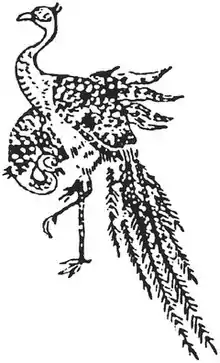Luan (mythology)
The luan (simplified Chinese: 鸾; traditional Chinese: 鸞; pinyin: luán; Wade–Giles: luan²) is a mythological bird in East Asian mythology. The name is sometimes reserved for males, while female luan are called Jīnjī (金鶏; lit. golden chicken).
| Luan | |||||||||
|---|---|---|---|---|---|---|---|---|---|
 Luan drawing, Wakan Sansai Zue, Japan | |||||||||
| Chinese name | |||||||||
| Simplified Chinese | 鸾 | ||||||||
| Traditional Chinese | 鸞 | ||||||||
| |||||||||
| Vietnamese name | |||||||||
| Vietnamese alphabet | loan | ||||||||
| Chữ Nôm | 鸞 | ||||||||
| Korean name | |||||||||
| Hangul | 란 | ||||||||
| Hanja | 鸞 | ||||||||
| |||||||||
| Japanese name | |||||||||
| Kanji | 鸞 | ||||||||
| Hiragana | らん | ||||||||
| |||||||||
Appearance
Chapters 7 and 16 of the Classic of Mountains and Seas describes the luan as inhabiting paradisaical areas where it sings spontaneously. In Chapter 11, its features are reminiscent of the fenghuang. It is said to trample on snakes while wearing one on its breast. In other sections, it is mentioned as carrying a shield.
The Shuowen Jiezi defines the bird as born from the sperm of Chìdì. It is red in color with five-colored markings. Its body is shaped like that of a chicken it sings in the five standard pitches and appears when hymns of praise are sung to rulers.
The Sancai Tuhui states that the bird is the transformation of a divine spirit.
The Japanese Wakan Sansai Zue of the Edo period further states that due to the viscosity of the luan's blood, it could be used as an adhesive for attaching strings to musical instruments.
By the Six Dynasties period, the luan became associated with the Queen Mother of the West.
Origin
It has been suggested that the luan's origins are the argus, peacock, or golden pheasant.
Meaning
Like the fenghuang, a sighting of the luan indicates peace. An early legend thought to be from the Warring States period states that the luan was presented as a tribute by northwestern tribes to King Cheng of Zhou as a symbol of submission to his virtue.[1]
References
- Strassberg, Richard E. (2018). A Chinese Bestiary: Strange Creatures from the Guideways Through Mountains and Seas. University of California Press. ISBN 9780520298514.